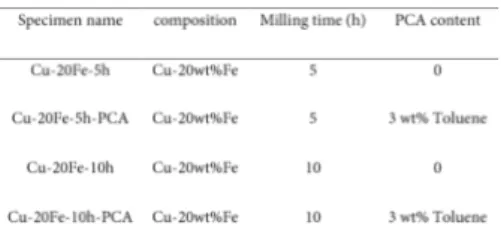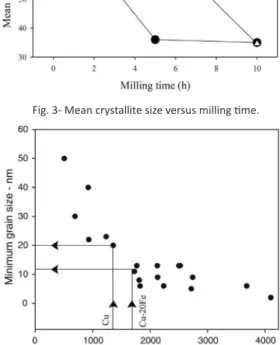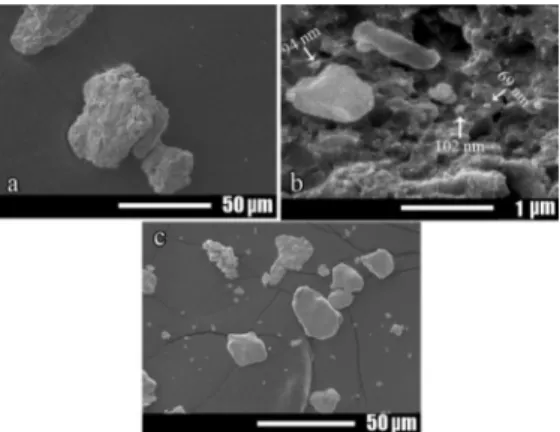Unraveling the Efects of Process Control Agents on Mechanical
Alloying of Nanostructured Cu-Fe Alloy
Mina Rabiee1, Hamed Mirzadeh*1, Abolghasem Ataie1
1School of Metallurgy and Materials Engineering, College of Engineering, University of Tehran, P.O. Box
11155-4563, Tehran, Iran
Recieved: 17 March 2016; Accepted: 31 May 2016 Corresponding author email: hmirzadeh@ut.ac.ir
ABSTRACT
Keywords: Crystallite Reinement; Mechanical Alloying; Nanomaterials; Process Control Agent.
Nanostructured Cu-20Fe alloy was synthesized by mechanical alloying process and the efects of process control agents (PCA) on the phase formaion, crystallite reinement and morphology of powder paricles were studied. The dissoluion of Fe into Cu matrix and the morphology of powder paricles were analyzed by X-ray difracion (XRD) technique and scanning electron microscopy (SEM), respecively. The mean crystallite size was approximated by the method developed by Williamson and Hall. It was found that in the absence of PCA (Toluene in the present work), the iron peaks vanish ater 5 h of mechanical alloying process and the mean crystallite size of the matrix decreases to 35 nm and large agglomerated paricles are formed during milling. In this regard, it was found that the addiion of PCA decreases the rate of crystallite reinement and formaion of solid soluion but does not afect the inal mean crystallite size. It was also found that the addiion of PCA during milling decreases the powder paricle size considerably and by prevening agglomeraion can lead to a iner powder paricle size compared with the iniial unmilled powders. It was also revealed that the efect of PCA on paricle size is much greater than the efect of milling ime.
1. Introduction
Mechanical alloying is one of the most promising and rapidly developing methods for synthesizing nanomaterials [1,2], in which the limits of solubility can also be enhanced signiicantly even for immiscible elements [3,4]. Repeated fracturing and welding of particles during mechanical alloying can result in appropriate mixing of constituents, which can lead to a change in solubility limits and formation of metastable solid solutions [1]. Excessive cold welding and formation of agglomerated particle might be a problem during milling, especially for ductile metals [5,6,7]. his can results to the formation of large agglomerates [5,6] or low powder yield [7]. herefore, process control agents (PCA) are usually added to the
powder mixture during milling to control the efect of excessive cold welding [8]. On the other hand, PCAs could afect the inal phase formation [1], change the solid solubility levels [9], the formation rate of solid solutions [8,9], the rate of crystallite reinement [9,10], alter the contamination levels [1], and the resultant mechanical properties [11]. Moreover, the efect of PCA has been successfully modeled by Canakci et al. [12,13]. herefore, it can be deduced that the efect of PCA is important in optimization of mechanical alloying process for each given system.
In the present work, a Cu–Fe solid solution was synthesized by mechanical alloying process with and without PCA addition to investigate the efect
Journal of Ultraine Grained and Nanostructured Materials https://jufgnsm.ut.ac.ir
Vol. 49, No.1, June 2016, pp. 17-21
of PCA on the rate of crystallite size reinement, the inal crystallite size, the rate of formation of solid solution, and the evolution of the size and morphology of powder particles. It should be noted that the mechanically alloyed Cu-Fe supersaturated solid solutions have received a great deal of attention due to their high strength and high conductivity. However, the efect of PCA on this system has not been systematically studied.
2. Experimental procedure
Commercially pure Fe powder (<150µm, 99.5% purity, Germany) and electrolytic copper powder (<150µm, 99.5% purity, China) were used as starting materials. Fig. 1 shows the SEM micrographs of the initial powders as performed by S360 Mv2300 scanning electron microscope. Mechanical alloying of the powders was carried out in a planetary ball mill with hardened steel vial and balls under argon atmosphere. he mixture of Cu-20wt% Fe was milled up to 10 h. In the beginning of milling, 3wt% of toluene was added for investigation of PCA efects. he ball-to-powder weight ratio (BPR) and milling speed were adjusted as 20:1 and 300 rpm, respectively. he details of the specimens are summarized in Table 1. Phase identiication or dissolution of Fe into Cu matrix was studied by X-ray Difraction (XRD) using a Philips PW-3710 difractometer with Cu-Kα radiation. he crystallite size of matrix was determined from the X-ray peak broadening technique based on the Williamson-Hall method. Finally, the morphology of mechanically alloyed products was studied by ield-emission scanning electron microscopy using a HITACHI S-4160 SEM.
3. Results and Discussion 3.1. Phase identiication
he XRD patterns of Cu-20wt% Fe along with those synthesized with the addition of PCA are shown in Fig. 2. For the samples synthesized without PCA, the Fe peaks vanish ater 5 h milling probably due to the dissolution of Fe in the Cu lattice. While Fe has negligible solubility in Cu lattice at room temperature, Eckert [14] et al. have reported the formation of fcc (Cu) solid solution with 60 at% of Fe. Moreover, in comparison with initial powder’s pattern, by continued milling the peaks become broad due to the crystallite reinement and introduction of lattice strain. hese results are in a good agreement with previous reports on mechanical alloying of Cu-based alloys [15,16].
As can be seen in Fig. 2, the high intensity peak of Cu-Fe alloy milled for 5h with addition of PCA shows some branches which could be related to the undissolved Fe. On the other hand, by additional 5 h milling, these branches vanish for the Cu-20Fe-10h-PCA due to the dissolution of Fe in the Cu lattice ater 10 h milling. herefore, it can be concluded that the addition of PCA postpones the dissolution of Fe. It can be imagined that toluene is adsorbed on the surface of powder particles and inhibits alloying. Shaw et al. [9] claimed that the efects of stearic acid and methanol as PCA materials on the prevention of excessive cold welding, the grain-size reinement, the lattice-strain increment, and the formation of Al-based solid solutions are most likely achieved via the adsorption on the metal surface and the lubricating function provided by these molecules. he former prevents the clean metal- to-metal contact necessary for cold welding, whereas the latter reduces the degree of plastic deformation of powder particles during each impact, which, in turn, slows down the grain-size reinement and the formation of solid solutions [9]. It should be noted that for other mechanically alloyed systems, it has been also reported that the
Fig.1- The SEM images of the iniial powders.
1
addition of PCA could change the solid solubility level and lead to a decrease in the rate of the formation of solid solution [1,8,9,17].
3.2. he efect of PCA on the crystallite size reinement
he mean crystallite size as a function of milling time for the Cu-20Fe system is shown in Fig. 3. As can be seen, in the case of milling without PCA, ater 5 h milling, the meancrystallite size decreased suddenly and there is no pronounced reinement by continued milling. However, the mean crystallite size of the Cu-20Fe milled for 5h in the presence of PCA difers considerably from that processed without PCA. his diference could be related to the amount of dissolved Fe for Cu-20Fe-5h and Cu-20Fe-5-PCA.
he above statement needs more explanation based on the melting points of the alloys [18,19]. Fig. 4 shows the minimum obtainable crystallite size of diferent elements based on their melting point [18]. As can be seen in this igure, by increasing the melting point, the minimum crystallite size decreases. Now, based on the phase diagram of Cu-Fe, the melting point of Cu solid solutions increase with the addition of Fe. As discussed earlier, in the presence of PCA, Fe does not dissolve completely in Cu lattice ater 5 h and hence the melting point of the resultant solid solution is lower, and as a result, the corresponding crystallite size is coarser.
Finally, ater milling for 10 h, Fe dissolves in the Cu lattice, and hence, the addition of PCA has no pronounced efect on the inal mean crystallite size as shown in Fig. 3.
3.3. he efect of PCA on the morphology of powder particles
Fig. 5 (a) and (b) show the SEM images of mechanically alloyed powder particles without PCA. Compared with the initial powders (Fig. 1), it is obvious that milling for 5 h results in an increase in the mean particle size, which means that excessive cold welding has occurred during milling. he formation of large particles in the Cu-20Fe-5h sample may be attributed to the presence of fcc crystal structure in which particles are easily deformed and cold welded to each other to form large agglomerates [5,8]. Fig. 5 (C) and (d) show the powder which mechanically alloyed with PCA for 5 and 10 h. In contrast to Fig. 5 (a), Fig. 5 (c) shows that the particle size of the sample milled for 5 h with PCA is much iner. By analyzing the image, it can be seen that, by addition of PCA during milling, the mean particle size of Cu-20Fe-5h decreases from almost 540 µm to 15 µm. In fact, PCA adsorb on the surface of the powder particles and minimize cold welding among powder particles, thereby inhibiting agglomeration [1,9]. herefore,
Fig. 2- The obtained XRD paterns.
Fig. 3- Mean crystallite size versus milling ime.
it can be concluded that addition of PCA during mechanical alloying is beneicial for producing Cu-Fe supersaturated solid solution with desirable particle attributes if enough milling time is applied to grant alloying and crystallite reinement. he igure also shows that the additional 5 h milling time leads to iner powder particles and the obtained powders ater milling for 10 h in the presence of PCA are iner compared with the initial unmilled powder particles. To better evaluating the efect of milling time, the milling process was continued without addition of PCA. Fig. 6 (a) and (b) shows the SEM images of Cu-20Fe-20h and compared with Cu-20Fe-10h-PCA in Fig. 6 (c). Fig.6 reveals that additional 10 h milling without PCA can signiicantly reduce particle size toward particle size of Cu-20Fe-10h-PCA, which was achieved by particle fracturing. However, the particle size ater 20 h is still larger. his proves that the efect of PCA on particle size is much greater than the efect of milling time. Fig. 6 (b) also shows that each powder particle is agglomerated of nanometer particles.
4. Conclusions
he Cu-20Fe supersaturated solid solutions were synthesized by mechanical alloying up to 10 h milling in the presence and absence of Toluene as the PCA material. he efect of Toluene on the phase formation, crystallite reinement and morphology of powder particles was studied and the following conclusion can be drawn from this work:
1. During mechanical alloying of Cu-Fe without PCA, Fe dissolved into Cu lattice ater 5 h milling and the mean crystallite size of Cu decreased to 35
nm. Also, large agglomerated formed by 5 h milling due to excessive cold welding and by additional milling, iner particles were formed.
2. he presence of Toluene during milling postponed the dissolution of Fe into Cu lattice and led to a decrease in the rate of solid solution formation and crystallite reinement. However, the addition of PCA did not change the inal mean crystallite size of Cu due to the dissolution of Fe by continued milling.
3. he powder particle size decreased considerably with addition of Toluene during milling and led to iner powder particle compared with the initial unmilled powder. It was also revealed that the efect of PCA (Toluene in this case) on particle size is much greater than the efect of milling time.
Acknowledgement
he inancial support of this study by University of Tehran and Iran Nanotechnology Initiative Council is gratefully acknowledged.
References
1. Suryanarayana C. Mechanical alloying and milling. Progress in materials science. 2001;46(1):1-84.
2. Enayati MH, Mohamed FA. Application of mechanical alloying/milling for synthesis of nanocrystalline and amorphous materials. International Materials Reviews. 2014;59(7):394-416.
3. Ma E. Alloys created between immiscible elements. Progress in materials science. 2005;50(4):413-509.
4. Shingu PH, Ishihara KN. Non-equilibrium materials by mechanical alloying (overview). Materials transactions, JIM. 1995;36(2):96-101.
5. Baláž P, Achimovičová M, Baláž M, Billik P, Cherkezova-Zheleva Z, Criado JM, Delogu F, Dutková E, Gafet E, Gotor FJ, Kumar R. Hallmarks of mechanochemistry: from nanoparticles to technology. Chemical Society Reviews. 2013;42(18):7571-637.
6. Pilar M, Sunol JJ, Bonastre J, Escoda L. Inluence of process
Fig. 5- SEM images of mechanically alloyed powder paricles, (a) Cu-20Fe-5h, (b) Cu-20Fe-10h, (c) Cu-20Fe-5h-PCA, and (d) Cu-20Fe-10h-PCA.
control agents in the development of a metastable Fe–Zr based alloy. Journal of Non-Crystalline Solids. 2007;353(8):848-50. 7. Machio C, Chikwanda H, Chikosha S. Efect of process
control agent (PCA) on the characteristics of mechanically alloyed Ti-Mg powders. Journal of the South African Institute of Mining and Metallurgy. 2011;111:149-153.
8. Sheibani S, Ataie A, Heshmati-Manesh S. Role of process control agent on synthesis and consolidation behavior of nano-crystalline copper produced by mechano-chemical route. Journal of Alloys and Compounds. 2008;465(1):78-82. 9. Shaw L, Villegas J, Luo H, Zawrah M, Miracle D. Efects
of process-control agents on mechanical alloying of nanostructured aluminum alloys. Metallurgical and Materials Transactions A. 2003;34(1):159-70.
10. Lu L, Zhang YF. Inluence of process control agent on interdifusion between Al and Mg during mechanical alloying. Journal of Alloys and Compounds. 1999;290(1):279-83.
11. Nouri A, Hodgson PD, Wen CE. Efect of process control agent on the porous structure and mechanical properties of a biomedical Ti–Sn–Nb alloy produced by powder metallurgy. Acta biomaterialia. 2010;6(4):1630-9.
12. Canakci A, Ozsahin S, Varol T. Modeling the inluence of a process control agent on the properties of metal matrix composite powders using artiicial neural networks. Powder
technology. 2012;228:26-35.
13. Canakci A, Varol T, Ozsahin S. Analysis of the efect of a new process control agent technique on the mechanical milling process using a neural network model: measurement and modeling. Measurement. 2013;46(6):1818-27.
14. Eckert J, Holzer JC, Johnson WL. hermal stability and grain growth behavior of mechanically alloyed nanocrystalline Fe‐ Cu alloys. Journal of applied physics. 1993;73(1):131-41. 15. Vishlaghi MB, Ataie A. Investigation on solid solubility
and physical properties of Cu–Fe/CNT nano-composite prepared via mechanical alloying route. Powder Technology. 2014;268:102-9.
16. Contini A, Delogu F, Garroni S, Mulas G, Enzo S. Kinetics behaviour of metastable equiatomic Cu–Fe solid solution as function of the number of collisions induced by mechanical alloying. Journal of Alloys and Compounds. 2014;615:551-4. 17. El-Eskandarany MS. Mechanical Alloying: Nanotechnology,
Materials Science and Powder Metallurgy. Elsevier; 2015. 18. Koch CC. Structural nanocrystalline materials: an overview.
Journal of Materials Science. 2007;42(5):1403-14.


